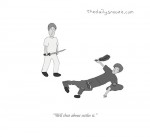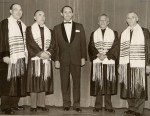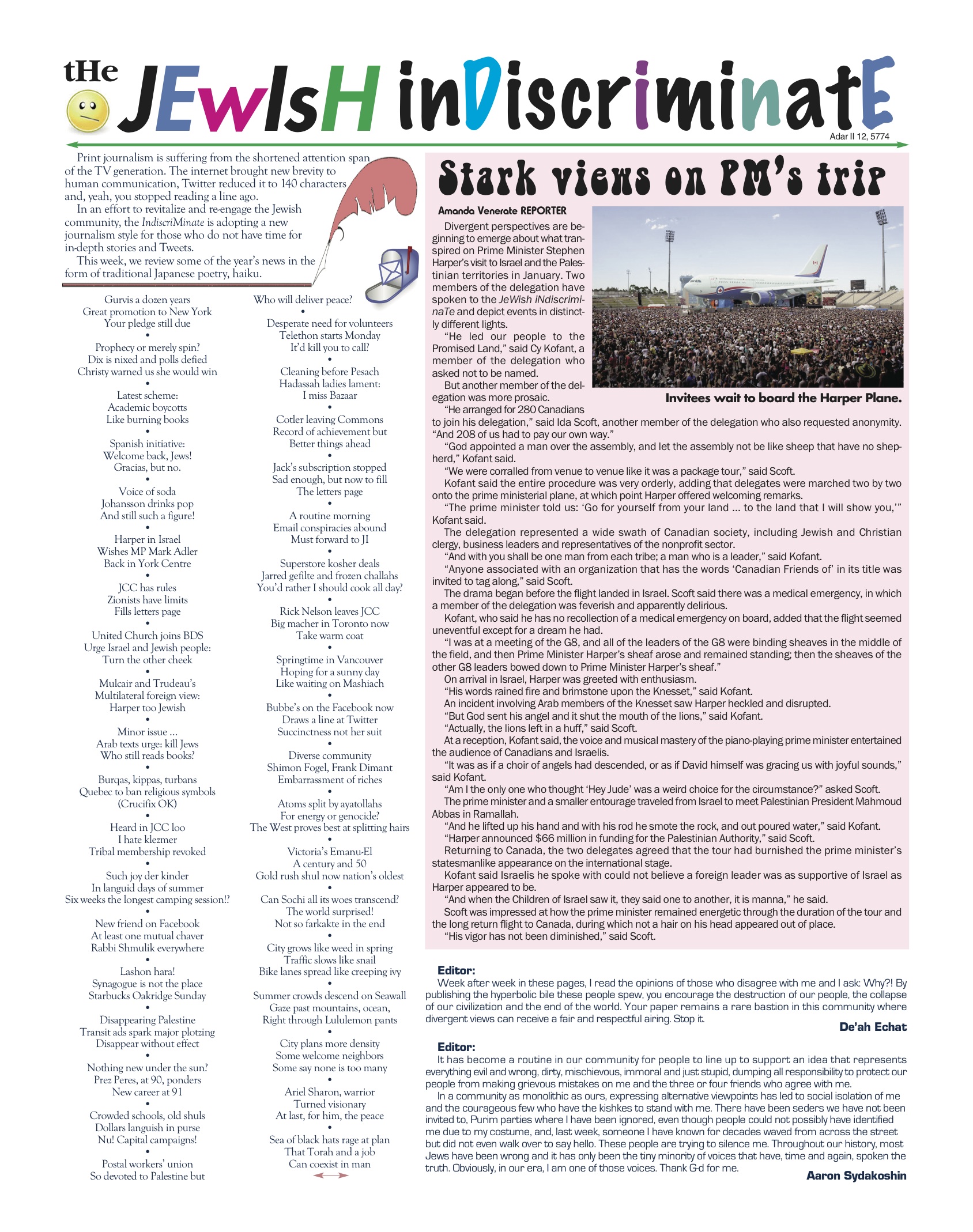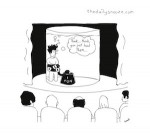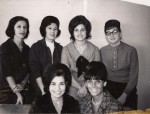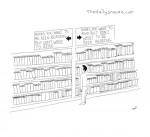For more cartoons, visit thedailysnooze.com.
Category: Life
Mystery photo … March 28/14
Cantor Herskovits and Schara Tzedeck Choir, Vancouver, 1955. (JWB fonds, JMABC L.14274)
If you know someone in this photo, please help the JI fill the gaps of its predecessor’s (the Jewish Western Bulletin’s) collection at the Jewish Museum and Archives of B.C. by contacting [email protected].
The JeWish InDisCrimInaTe
Add hints of automation for unique and modern home design
Recessed LED home lighting can make a big statement, inside and out. (photo by Mark Whitehead)
Customization, once seen as a luxury, can now be found in all facets of consumer products. The newest trend: controlling your home with your fingertips from anywhere in the world.
With the launch of everything electronic and motorized, handheld devices such as your smart phone or tablet are now able to control almost anything with the touch of a finger. With the newest builds and renovations, home automation, in some form or another, is being specified into the design. Technology has catapulted the use of home automation to the next degree and has become more popular – and more affordable.
Home automation spans a wide breadth of components: from controlling a home’s lighting and window coverings by using a smart phone or tablet, to scheduling timers throughout the day, to turning on and off your central heating and home-entertainment systems. New builds and renovations are taking advantage of open walls, and the trend of installing hidden speakers, wireless routers and other normally obvious audio components into the walls makes the final interior design seamless. Even motorized tracks can be hidden within the ceiling, hiding drapery tracks, for example, which creates additional visual height with true floor-to-ceiling draperies.
Trending with window shades is the option for motorization, as well. The sleek and contemporary designs of roman shades, cellular blinds, even the newest in vertical blinds, can be motorized and fit in perfectly with contemporary home décor. And with many more affordable products on the market, consumers are able to have luxury items without paying the luxury ticket.
The popularity of LED lighting is making a huge impact in interior design. Custom LED home lighting has moved from just changing a light bulb to installing fully recessed indoor perimeter lighting, and even offers various outdoor applications, such as illuminating walkways, pathways and porch lights.
Kitchens are the heart of any home, and esthetic is just as important as functionality in the design of a great kitchen. Hardware mechanisms that provide soft-close drawers and cabinets add an extra bit of luxury to a kitchen’s everyday use. Whether choosing contemporary handles in clear acrylic and chrome, or streamlined and contemporary push-touch cabinetry instead, the selections of hardware are endless.

(photo by Mark Whitehead)
Acrylic elements are also creeping into today’s homes in versatile ways other than in the kitchen. Resembling glass, acrylic gives the illusion of glass without the fragility and weight. One of the ways this medium is making a statement in contemporary interior home design is molded into contemporary sculptures. On its own or in a collection, acrylic sculpture can offer a focal point to any room. Some acrylic sculpture suppliers give the option of custom colors, adding an extra personal touch to a statement piece or collection. Especially when beautifully lit, acrylic sculpture brings simple elegance to the home.
Don’t forget about the importance of fabric in home design. This year, texture is big and the more layered the better! Mix different textures with bold patterns to make a statement, or mix soft and sleek textures to create a luxurious atmosphere. Fabrics enhance a room’s décor, creating soft, easy lines and offering points of visual interest. By playing with color and lots of layered textures, interiors are warming up to cheerful design and easy, comfortable living.
Michelle Diaz is a design assistant at RodRozen Designs. The firm, now celebrating its 10th anniversary, is proud of its achievements in the interior design and construction trade. Consisting of co-owners Derick and Steven RodRozen and a design team, RodRozen Designs strives to create uniquely stunning and luxurious homes throughout the Lower Mainland. For more information, visit rodrozen.com or email [email protected].
Shockeling: an age-old tradition
Shockeling can help you achieve kavanah, intense concentration with Hashem through the medium of prayer. (photo by Ashernet)
The language of Yiddish is one of the most unique forms of expression. It is in fact untranslatable. Tomes have been written on it. Its vocabulary and expressions are so self-descriptive. Many words have found their way into the English vocabulary. Who can translate the word nu, or shlep, or bittere gelegte or … shockel? It is this last word in which I am interested here.
Shockel: a description of the rhythmic, swaying movement that Jews all over adopt when they are engrossed in prayer. I have been intrigued and bemused over many years of observation of how Jews pray, and this script is a description of the main styles that tend to be adopted. They are often reflective of the personalities of their users. The next time you go to shul, watch the men in prayer, and see if you can identify the styles. Try them out yourself, and maybe you will be able to choose one that really stimulates you into an attitude of devotion and prayer.
The simple shockel
This is a gentle rhythmic bow from the waste with a pelvic lunge as you straighten up – a very simple, easy-to-learn movement. But there are some variations, for instance, the simple shockel with head extension. Here, you proceed with the movements of the simple shockel, but it is done rather slower. The body tends to fall forward until the point at which it appears to overbalance, at which point the head is stretched forward very rapidly while the body straightens up. All in all, an intriguing movement, and very good for the cervical vertebrae, if you don’t put your neck out while practising it.
The friendly simple shockel with lateral movement
Here, instead of bending forward from the waist, you twist alternately to the left and the right, as if you are addressing a large audience. Combined with a head extension and a slight smile on the face, the incumbent gives the impression of being a really friendly fellow. A style that you may well want to emulate. But be careful of straining the vertebrae. It could take weeks to recover.
Charlie Chaplin
An entertaining variation of the friendly shockel with lateral movement, you stand with your feet slightly apart, toes pointed outwards – the further the better. (Some folks can do this movement with the toes pointed out about 90 degrees!) The trick is to keep the legs and back quite stiff. You bow from the waist to the left and simultaneously lift the right toe. Repeat to the other side. When accompanied by a glazed look in your eyes, the effect can be highly spiritual.
Walking on the spot
Now, here is an interesting movement. This overcomes the restrictions of keeping the feet together during the Shemoneh Esrei prayer, when you are not allowed to separate the feet. The movement consists of simply bending your knees alternately as you bend forward. A fine variation is to raise the toe of the leg whose knee is bending, simultaneously with the heel of the opposite foot. It’s very good exercise for the muscles of the feet, but needs practise to coordinate properly.
Alternate bowing with ankle twist
When I first saw this, I was very impressed, as it requires tremendous coordination of rhythm. It shouldn’t be done during the Shemoneh Esrei because it requires the feet to be slightly separated, but one wonders…. The technique is simple, but requires a lot of practise. With the feet slightly separated, you bow rhythmically to the left and right alternately, as in the simple shockel with lateral movement. But here is the catch. As you bow to the left, you raise the right ankle slightly, and similarly on the other side. Once you have mastered this movement, you proceed to move the raised foot in a circular, back-and-forth movement, similar to squashing a bug. A beautiful thing to watch, and one certainly worth the effort of learning.
The lunge
I first saw this style used in a Chassidic community in Israel. The congregant stands sideways with one foot ahead of the other, as if he is prepared for a fencing competition. He then proceeds to lunge forward and back in a rhythmic motion in time with his prayers.
The lunge with second thoughts
The basic lunge is very good for the lungs, if combined with proper breathing, but it reaches perfection in this variation. The operator goes into the lunge movement, but then draws up suddenly as if he has second thoughts, and draws himself back rapidly to an upright position. It imposes a tremendous strain on the back muscles, since they have to go into reverse at the very instant that the body has reached its maximum momentum in a forward direction, so be careful before attempting this shockel. If you work into it slowly, and perfect it, you could be the admired hero of the congregation.
The hula hoop
This is a relaxing movement, most suitable for use during intermediate prayers, while you are building up your spiritual resources for the Shema or Shemoneh Esrei. You stand upright with your feet slightly apart, and exercise a rotational movement as if you are trying to maintain a hula hoop in motion. It is particularly good for the stomach muscles, and will help tighten any slightly (or not so slightly) sagging abdominal area.
The vibrating calf
This movement is usually used by persons who are either in a hurry to get to the end of the service, or who are eagerly anticipating the arrival of Moshiach. It is executed by standing perfectly still, and rapidly vibrating the muscles of the calf from side to side. It may sound simple, but it can look pretty spectacular if done with finesse.
The drunken swagger
This movement is performed with ease if you have had a couple of tots of whisky prior to entering your house of prayer. However, I have seen it done very effectively by folks who are stone-cold sober. You need to stand with feet fairly widely apart, with knees bent, hips thrust forward and shoulders well back. The trick is to give the appearance that you are about to collapse backwards while you sway gently from side to side. A glazed look in the eyes contributes enormously to the effect.
The wanderer
This is more an expression of urgency than style. All congregations have their wanderers. They wander around aimlessly during the service, walking determinedly in one direction, and then stopping as if they have suddenly changed their mind, and then walking back again. Many of them wander around and examine every detail in the shul – the books, the seats, the cracks in the walls. Some even pick up objects and examine them. Some intone loudly as they meander. Others simply appear lost. I remember one wanderer who was actually scary. A rather big, heavily bearded guy who would fix me with a stare from the opposite side of the shul, and then start to walk determinedly in my direction. As he approached, his eyes opened wider and took on an aggressive look. He would come within a distance of about one foot, thrust his face into mine, and then abruptly turn around and wander back again. He would repeat this a few times during the service.
The helicopter movement
This is a rotational motion from the waist up. The upper body rotates in a circular movement, building up momentum, and the hands swing out to the sides, lifting up higher and higher as the rotational speed increases. (Of course, you need to know the prayers by heart for this version of the shockel.) At top speed, the effect is not unlike a helicopter blade rotating and, indeed, sometimes there is a very real fear that the operator will take off vertically. This one takes years of practise.
These descriptions should give you a renewed interest in and enthusiasm for davening. But be warned – it is easy to be distracted from the real purpose of it all, which is to achieve kavanah, intense concentration with Hashem through the medium of prayer. So, please take these descriptions in the spirit in which they were written.
Dr. Stan Shear emigrated in 2004 to Vancouver from South Africa, where he taught information systems at the University of Cape Town until his retirement. He also has officiated as a chazzan for the past 30 years, both in South Africa and Vancouver.
This week’s cartoon … March 7/14
For more cartoons, visit thedailysnooze.com.
Legacy Senior Living is “about living life your way”
An architectural design rendering of the Leo Wertman Residence at 611 West 41st Ave. (photo from Gomberoff Bell Lyon Architects Group Inc.)
When Legacy Senior Living opens in the Oakridge neighborhood in July 2014, the 91-suite, independent-living seniors residence will pay tribute to a man who believed in building community. Built by the Wertman Group of Companies, it was created in honor of Leo Wertman, who founded the company back in 1962.
According to material provided by the company, Leo Wertman came of age in Ruzaniec, Poland, and was the only survivor of his family during the German occupation. As a teen, he became a Polish partisan, participating in missions to defy the occupation and emancipate Poland. In the process, he became a protector to many Jewish women and children, as well as the sick and elderly who sought shelter in the forest outside the city limits of Lublin and Ruzaniec. By night, he would venture into town, returning with food and medical supplies that helped keep some 200 displaced, hidden Jews alive during the occupation. Later in his life, he moved to Canada with his wife Regina and children Joseph and Rochelle. His business origins were manual labor and a small scrap-metal endeavor that he built up until he had the funds to invest in residential real estate in the 1960s. In a fast-growing city like Vancouver, he believed people would always need somewhere to live. According to the family, he became known as the “Provider” for the role he played during the war, and it was one he lived up to until his passing in the 1980s.
Meanwhile, the business was expanding and Wertman’s son became actively involved, helping it grow from a few apartment buildings to a large development company and real estate management group. Today, this private company includes grandson Jason Wertman, who serves as vice-president of Legacy Senior Living.
The Wertman Group has built several higher-end residential/condominium buildings on the west side of Vancouver, and it manages rental properties on the North Shore from its headquarters at 1199 West Pender.
The Wertman Group has made its mark on the Lower Mainland in a variety of ways. The company’s portfolio includes the Hycroft Medical Centre and the Guildford Medical Centre, two landmark medical buildings that were overhauled, renovated and re-tenanted. It has built several higher-end residential/condominium buildings on the west side of Vancouver, and it manages rental properties on the North Shore from its headquarters at 1199 West Pender.
Beyond business, the Wertmans have a legacy of donating to causes in Israel as well as to organizations serving the local Jewish community, including the Vancouver Holocaust Education Centre, Vancouver Talmud Torah, Lubavitch B.C., Jewish Federation of Greater Vancouver and Schara Tzedeck Synagogue.
“With Legacy Senior Living, our goal was to create an outstanding senior living residence in Leo’s honor, right here in the heart of Vancouver,” said Jason Wertman by telephone. “We want it to be a place where seniors can stay active and involved, living creative and fulfilling lives – a place where great food, friendships, culture and thoughtful living spaces will combine as the ideal lifestyle community.” The residence was designed to promote a healthy, independent way of life that highlights personal choice, convenience and exceptional service. “People who have some gas in their tanks can come here to reclaim quality of life and focus on being active and healthy,” he added.
Wertman describes Legacy Senior Living as being comparable to a Four Seasons Hotel. “It’s truly luxury living, with high-end finishes and a boutique style. The suites, which will be available exclusively for rental and will range in price from $3,750 to $7,700 per month, feature video-monitored entrances, automatic keyless entry, three elevators and remote-controlled blinds.”
“We’re right in the heart of the Jewish community, with easy access to shops, physicians, services, parks and familiar neighborhoods, and the availability of a town car transportation service will help residents move around their local catchment area.”
The location is a big draw, noted Carol Omstead, managing director. “We’re right in the heart of the Jewish community, with easy access to shops, physicians, services, parks and familiar neighborhoods, and the availability of a town car transportation service will help residents move around their local catchment area.”
Life at Legacy includes a selection of dining choices, a concierge service and a wellness navigator, who can give advice and information to residents when and if needed. Jewish residents will have ample opportunities to continue their traditions, including Oneg Shabbat with a special musical performance by Annette Wertman on Friday afternoons, kosher-style meals (with strictly kosher meals available for those who require them) and the town car service, which can help them commute to the synagogue of their choice. “Our goal is to keep all cultural groups connected to their traditions,” Omstead said.
“We’re gearing towards the Jewish community,” added Wertman. “Our target market is the same as that of the Jewish Community Centre and the Richmond Country Club. The Jewish community is not enough to support us entirely, so we’re open to everyone. But the residence is geared towards and was inspired by the Jewish community.”
Omstead said Legacy was designed for seniors who want their golden years to be a time of growth and development. “It’s about living life your way, preserving and enhancing your activity level and independence” she said. “When you’re in a positive environment like Legacy, you can achieve great things.”
The seniors residence that most closely resembles Legacy is Tapestry, which has locations in Kitsilano and on the south campus of the University of British Columbia. What sets Legacy apart is that more meals are included, there is transportation available to residents seven days a week and its central location in Oakridge. Also, its ownership. Omstead added that the company is particularly suited to serve the local population. “Because we’re right here, we’re really attuned to the community we serve,” she said.
Wertman said his family is excited about the development, one of their biggest projects to date. “It’s consuming all our time and energy, and the suites are being rented out quickly,” he said. “Everything we have now is from the foundations that my grandfather Leo built, so, in a sense, this is his legacy project.”
The presentation centre, now open at 2827 Arbutus, at 12th Avenue, is open Monday to Friday, 9:30 a.m.-3 p.m, and all day Saturday and Sunday. A courtesy shuttle service in a dedicated Legacy Senior Living 2013 Bentley is available for those who don’t drive. Call 604-240-8550 to arrange for a ride during the show suite hours.
Lauren Kramer, an award-winning writer and editor, lives in Richmond, B.C. To read her work online, visit laurenkramer.net.
Mystery photo … Feb. 28/14
National Council of Jewish Women Israeli brunch, Vancouver, B.C., 1965. (JWB fonds, JMABC L.13972)
If you know someone in this photo, please help the JI fill the gaps of its predecessor’s (the Jewish Western Bulletin’s) collection at the Jewish Museum and Archives of B.C. by contacting [email protected].
This week’s cartoon … Feb. 28/14
For more cartoons, visit thedailysnooze.com.
How do people remember?
There is no stipulated time in life when we start “forgetting.” We all forget. As we increase our knowledge, so also we begin to forget: an item here, an occurrence there, a dangling thread that goes nowhere. Sometimes retrieval is simple: a particular smell, sight, sound or touch may jog the memory and most of what we have forgotten comes flooding back and we recall so much. Sometimes, it is not, and the memories fail to come.
Spending time with old (i.e. longtime) friends, one often takes a walk down memory lane. Soon, we are recreating an entire evening, for example, of an event that happened some 25 years ago and pictures flood in helter-skelter – we cannot wait to recall this or that person, how we looked and felt, what we ate or where it all took place.
There is much nostalgia that we recall with wistful and loving good feelings. When we think about a close chum who was special, we remember our times together; when we open a drawer and our eyes spot a long-forgotten photo or trinket lodged at the back, we relive a past moment.
Not everything is pleasant to remember or rehash, of course. Sometimes in the remembering, we re-feel the pain of long ago, and the sadness that often accompanied the ache. Even though time has passed and healed so many wounds, there are some memories that time does not allow us the forgetting.
Remembering is not heartbreaking per se; it is simply that we are looking through the other end of the telescope. The past is not as sharp or as large as the present and, in that moment of reflection, it appears so far away.

How do we remember? A touch on the arm, a particular look in someone’s eyes, a suit or a dress found in the closet.
When we start on a journey into the past, we are often off and running, breathlessly gulping down gobs of stuff that hasn’t crossed our mind in ages. We wonder how So-and-so is. Is she still around? How many kids did she and her “no-goodnik” husband end up having? Well, he was a character of the first waters, that’s for sure!
At another time, we might think to ourselves, I remember that handsome guy who used to come to the club; for the life of me I can’t recall his name … but I remember he was a damn good dancer and I loved being held and gently beguiled around the floor. Wonder if my friend in Australia would remember him? There was something about him having more than a drop or two of royal blood – from his father’s side, because his mother must have been Jewish … and, horror of horrors, we heard he was a bastard! (We didn’t use words like “illegitimate” back in those days where I came from.) Somehow, my friends and I didn’t seem to mind.
I could go on. One mental image leads to another so swiftly and a part of one’s life is relived in sizzling rapidity. We sometimes stop to examine a nugget, turning it this way and that, enjoying the feelings, the movements, the music. Not only do we not miss a beat, but we recall the tiniest details sometimes: faces, antics, what we ate, even the weather. Remember how it rained that night? I had to throw away my shoes! And so it goes. Or so it goes for us on such journeys in time.
Is this traveling safe? Of course it is! However, we are not meant to sit and brood for too long on the past. A dip here and there into something is quantum sufficit, and we do our best not to dwell unduly.
Is it time well spent? Should we be doing something more worthwhile? Somehow I get the feeling that we all need to connect with the past; with our pasts. It is like connecting the dots of our personal history and, in that way, somehow legitimizing who we are; not only who we are today but who we were then. Hence, these rememberings are very special, very important.
You can find your genetic makeup but that won’t tell you about your grandfather’s first suit, or how fast he outgrew it! Or how nerdy he felt wearing it for his bar mitzvah.
How much do you, dear reader, know about your parents’ rememberings? What do you know about your grandparents’ memories? Do you have a sense of who you are in that way? You can find your genetic makeup but that won’t tell you about your grandfather’s first suit, or how fast he outgrew it! Or how nerdy he felt wearing it for his bar mitzvah.
Events usually are recorded and can be recalled. However, it is being able to sit down comfortably next to your parent or grandparent and “chew the fat,” so to speak, that is truly meaningful. The plum in the pudding is the rare offering of a safta’s or a bubbe’s feelings, a saba’s or a zayde’s memory, and the contemplation today about how it was in the yesterdays of their lives. When a parent or a grandparent begins, “Oy, I must tell you,” it is in that moment that you start to get a sense, a brief glimpse, not so much of how it must have been, but rather how it felt.
Engaging in this sort of companionship is a win-win situation. A safta, for example, feels tremendously good, almost like she’s making you a meal, feeding you once again. It is that sense of giving, sharing, depositing for safekeeping. And, really, it is so much less exhausting and stressful compared to making another batch of komish broit, another bowl of matzah ball soup; never mind the washing up after! And you feel strengthened and joyful receiving the precious gift of a part of your heritage, which is unique to you and your family. It’s a little bit of your history, as well as a piece or two of the fabric of the community in which you live.
It is never too soon to have this type of interaction. It is sometimes too late – I never had the good fortune to know my grandparents, who came from Baghdad in Iraq and Persia (Iran today). My mother died when I was 12. My knowledge of my forebears would fill less than a page. This is my tragedy. Researching the history of these Jewish communities is akin to a starving person scratching for food from a parched earth: too much desert with nary a signpost to sustenance.
So, how do we remember? You can look through a box of photographs but if no one is there to tell you at whom or what you are looking, or if you didn’t experience those moments yourself with your loved ones, you might as well add the pictures to your recycling pile and take them to the curb. As an elder, I say to you: we need to be remembered – not just for our health and happiness, but for your sake as well!
Seemah C. Berson, born in Calcutta, India, in 1931, has lived in Vancouver since 1954. Married to Harold, with four sons and various grandchildren, baruch Hashem, she and Harold are longtime members of the Peretz Centre for Secular Jewish Culture. Author of I Have a Story to Tell You (Wilfred Laurier University Press, 2010), comprising the personal recollections of Jewish immigrants to Canada between 1900-1930, subsequently working in the Canadian garment industries, she is a freelance writer and occasional dabbler in art, children’s poems and stories.

